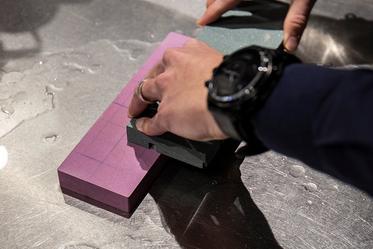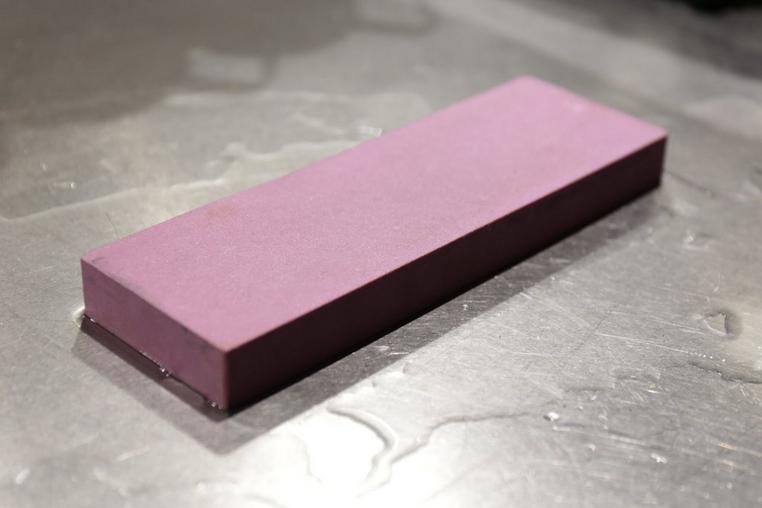How do you maintain sharpening stones?
Sharpening stones need to be lapped in time. Maintenance, after all, is key to make sure your tools stay in great shape. The same applies to your precious sharpening stones. In time you will see how your knives affect your sharpening stones: they become hollow in the middle. That is when it is time to lap them.
There are multiple ways to lap or flatten your sharpening stone. Some recommend sandpaper, but it works better and faster to use a product that was specifically made to maintain sharpening stones. But what can you use to lap a sharpening stone?
Lapping stones
To clean and flatten sharpening stones we use lapping stones. These are often made from the same material as a ceramic sharpening stone, but with an extra-coarse grain. It is important that you use a lapping stone with a coarser grain size than the sharpening stone you wish to maintain. This means: use a stone with a lower grain size than the stone you want to flatten. Often these lapping stones are enhanced with grooves in the sharpening surface that get rid of the sharpening particles.
Diamond-coated sharpening stones
A diamond-coated sharpening stone is perfect when flattening whetstones (made from another material than diamond). Diamond is namely harder than any other abrasive. A diamond-coated sharpening is also less prone to wear out than a lapping stone. Do occasionally rinse off the diamond-coated sharpening stone. It is namely not enhanced with the grooves a lapping stone does have.
How do you properly lap your sharpening stone?
You use both stones in the same way. You place the sharpening stone you wish to flatten on its back on a flat surface, the sharpening side facing up. To make sure you can check that the stone is flattened properly you mark the surface you wish to sharpen with horizontal and vertical lines. As mentioned before it is possible that the sharpening stone, after being used for some time, has become hollow in the middle. As such the lines on the outsides will disappear faster as you flatten your stone. The sharpening stone is flat when you have removed all lines of the sharpening stone.
After marking the stone add water. Then you can start lapping. Move the lapping stone (or diamond-coated sharpening stone) with a diagonal or rotating movement over the lapping stone. By using all corners as starting and ending point, you make sure you lap the entire surface. As soon as all lines are gone you rinse off the sharpening particles under the tap. And that's it! Your sharpening stone is good to go again.
Lapping system
A third option when lapping sharpening stones is using lapping powder and a lapping system. A lapping system is a sheet of iron or glass. You add a bit of water and an abrasive like rock-solid silicon carbide or aluminium oxide powder. By moving your sharpening stone - which you also marked first - in a rotary motion over the mixture, you end up with the same results as with a lapping stone. Only a little bit of lapping powder is enough. The advantage of a lapping system is that they last a lot longer than a lapping stone.
What do you need to lap a sharpening stone?
In short:
- A lapping stone, diamond-coated sharpening stone or lapping system
- An old or hollow ceramic sharpening stone
- A marker or pencil
- Water
How often do you need to lap your stone?
How often you need to lap depends on how often you sharpen your knives and the hardness of the sharpening stone. By using one of the methods on a regular basis you extend the life of the stones. Make sure the stone does not become hollow, so lap it often. As such you don't have to remove as much material. Ideally you should use a lapping stone every time before or after you sharpen your knives.
Storing your sharpening stones.
Even after sharpening and maintaining the sharpening stone you need to take good care of it. Leave the sharpening stone (and the lapping stone if you used it) out to dry at room temperature for a couple days. Not in the sun or any other hot place! This can cause the sharpening stone to crack. Once dry properly store it! Not separately in a kitchen drawer, but for instance in a box in a cabinet.
In addition to materials to maintain your sharpening stones, we have many other sharpening stone accessories. Think of sharpening stone holders, dressing stones, whetstone guides and many more. Check out all accessories here!
























?%24center=center&%24poi=poi&%24product-image%24=&fmt=auto&poi=%7B%24this.metadata.pointOfInterest.x%7D%2C%7B%24this.metadata.pointOfInterest.y%7D%2C%7B%24this.metadata.pointOfInterest.w%7D%2C%7B%24this.metadata.pointOfInterest.h%7D&scaleFit=%7B%28%24this.metadata.pointOfInterest%29%3F%24poi%3A%24center%7D&sm=c&w=373)


















